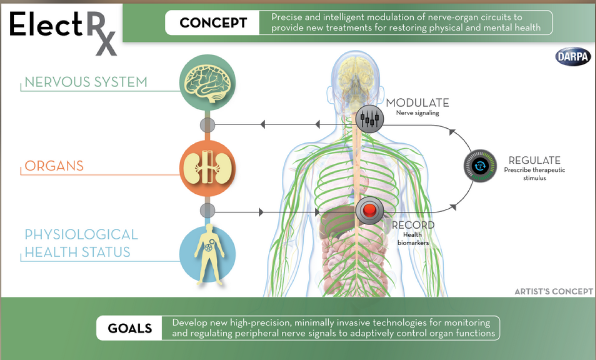The Defense Advanced Research Projects Agency (DARPA) — the arm of the United States military responsible for technology development — has also funded development of various technologies which have had wide non-military application and benefits. One such advancement was the NLS computer networking system, the first hypertext system that was also an important precursor to the now-ubiquitous graphical user interface (GUI) that was popularized by Apple Computer in the 1980s. The original name of the agency, established during 1958 in response to the then-Soviet Union’s successful Sputnik space launches of 1957, was: “Advanced Research Projects Agency (ARPA)”. It was changed to “DARPA” (for Defense) in March 1972, reverted to “ARPA” in February 1993, then back to “DARPA” in March 1996. DARPA was (as ARPA).
Under whichever name, the mission of Arlington County, Virginia-based ARPA/DARPA has consistently been to ensure that U.S. military technology remains more sophisticated than the defense capabilities of the nation’s potential enemies. From ARPAs original 1958 mission to prevent more technological surprises like the Sputnik launch with which, the Soviets beaten U.S. into space, has evolved has evolved and broadened its range of focus and responsibility over time.
Recently, DARPA has sought proposals for development of cutting-edge neuromodulation capabilities aimed at maximizing immunological, physical and mental health of both current military service members and veterans.
Many types of chronic inflammatory and mental health illnesses that affect military Service members, veterans, and civilians involve abnormalities in the body’s peripheral nervous system whose activity is a key element in organ function. Peripheral nerve signal monitoring and targeted regulation are believed to hold great promise for helping patients restore and maintain good health without resort to surgery or drugs.
Currently, use of neuromodulation devices is typically regarded as a last resort, due to their relative bulk (roughly the size of a deck of cards), requirement for invasive surgical implantation, and tendency to induce side-effects because of their lack of precision. However, DARPA’s Electrical Prescriptions (ElectRx) program is inviting innovative research proposals that could be instrumental in a transformation of neuromodulation therapies to first choice from last resort in therapeutic address of a broad range of disease categories.
The goal of ElectRx (pronounced “electrics”) is the development of breakthrough technologies that would harness the body’s intrinsic neurophysiology in restoration and maintenance of optimum health.
Initiated in support of President Obama’s brain initiative, the ElectRx program is also focused on accelerating growth in the understanding of specific neural circuits and roles they play in determining health or disease, and exploring potential for developing high-precision, minimally invasive technologies for neuromodulation of nerve circuits that regulate organ functions in order to restore and maintain human health by boosting the body’s self-healing processes. Future therapies based on targeted peripheral neural stimulation could promote self-healing, reduce dependence on traditional drugs and provide new treatment options for illnesses.
For example, the peripheral nervous system monitors the status of internal organs constantly in order to help regulate biological response to infection, injury or other health-affecting imbalances. However, when this regulatory process malfunctions due to injury or illness, peripheral nerve signals can actually make matters worse, resulting in pain, inflammation, and/or immune system dysfunction. Consequently, it’s plausible that precise modulation of the peripheral nervous system might serve to managed some currently difficult-to-treat afflictions more effectively than reliance on conventional medical devices or medications.
Potential neuromodulation targets could be recently identified circuits involved in immune system function regulation as part of treatment for a wide range of inflammatory diseases, such as rheumatoid arthritis, systemic inflammatory response syndrome and inflammatory bowel disease. ElectRx is also targeting improvement in peripheral nerve stimulation treatments for brain and mental health diseases and conditions like epilepsy, traumatic brain injury (TBI), Post-Traumatic Stress Disorder (PTSD) anxiety, and depression.
“The technology DARPA plans to develop through the ElectRx program could fundamentally change the manner in which doctors diagnose, monitor and treat injury and illness,” DARPA Biological Technologies Office Program Manager Doug Weber observes in a release. “Instead of relying only on medication, we envision a closed-loop system that would work in concept like a tiny, intelligent pacemaker. It would continually assess conditions and provide stimulus patterns tailored to help maintain healthy organ function, helping patients get healthy and stay healthy using their body’s own systems.”
An objective for ElectRx is to leverage advanced feedback-controlled neuromodulation technologies that would target the specific peripheral neural circuits responsible for controlling organ function. This would facilitate monitoring of health status and intervention as needed for timely delivery of patient-specific therapeutic stimulation patterns engineered to stimulate restoration of healthy physiological states using ultraminiaturized devices requiring minimally invasive insertion procedures such as via needle injection.
“Many chronic illnesses occur when the body’s natural neuroelectrical and biochemical rhythms are disrupted, like playing wrong notes in music,” says Dr Weber. “ElectRx seeks to understand what the right notes are for each person and provide real-time treatment to help the patient achieve and enjoy a harmonious, healthy baseline. Peripheral neuromodulation therapies based on ElectRx research could help maximize the immunological, physical and mental health of military Service members and veterans.”
DARPA expects ElectRx proposal submissions to identify a specific disease of interest on which to concentrate study and development of treatments. Determination of overall program success will be based on advancement of minimally or non-invasive patient interface technologies, and their capability to target specific nerves without inducing side effects, as well as biological input/output pathways validation, and potential for translating derived knowledge into integrated, closed-loop neural-visceral interfaces for health monitoring and maintenance.
Specifically, the DARPA ElectRx is soliciting research proposals for creation of closed-loop neuromodulation systems designed to achieve therapeutic benefits through utilization of the body’s own neurophysiological circuits. Toward this objective, ElectRx will simultaneously work to stimulate greater biological understanding and technology development. ElectRx’s mission is to develop and leverage fundamental anatomical and physiological understanding of spinal cord and peripheral neural circuitry that mediates health status — this knowledge to be leveraged toward design and demonstration of feedback-controlled neuromodulation systems that would directly regulate immune system functions and CNS disorders. Meanwhile, parallel, development of technology focused on next-generation minimally-invasive neural interfaces and biosensors are projected to permit interacting with neurophysiology of interest along with unmatched spatiotemporal resolution, precision, and specificity. Neuromodulation treatments emerging from the research and development will be automatically and continuously tuned for optimization with each individual patient’s unique physiology without producing off-target effects.
DARPA has scheduled a Proposers’ Day for Tuesday, December 16, 2014 for the purpose of familiarizing potential participants with the ElectRx program’s technical objective. The event will be held at the Capitol Conference Center in Arlington, Va. Registration is closed.
DARPA’s Proposers Day Special Notice document describing specific capabilities being sought can be viewed at:
http://go.usa.gov/6zpW
A Broad Agency Announcement providing full ElectRx program technical details is available at:
http://go.usa.gov/F88T
For more information, visit:
http://1.usa.gov/1ySurqj


